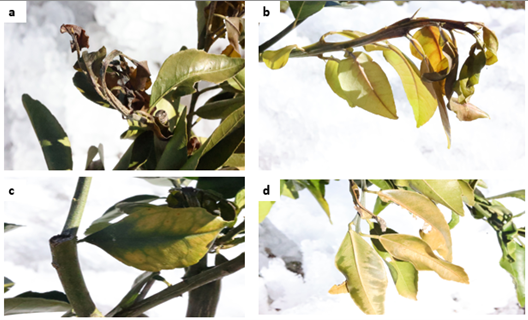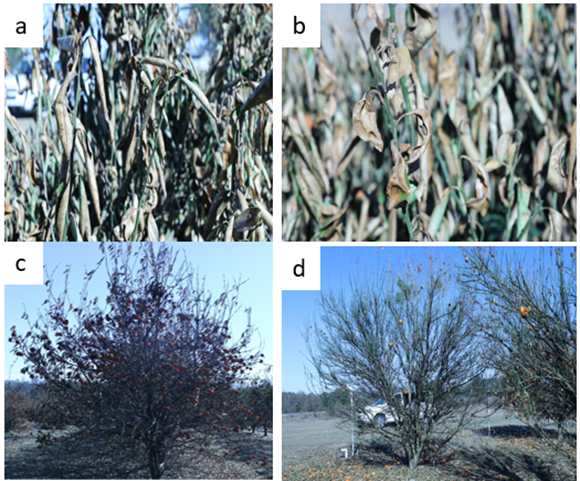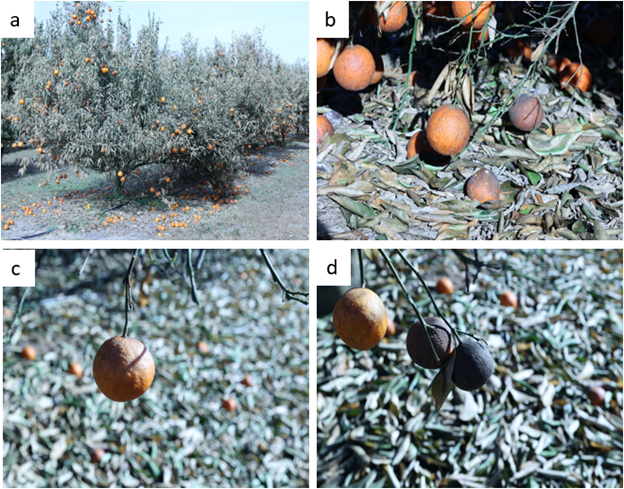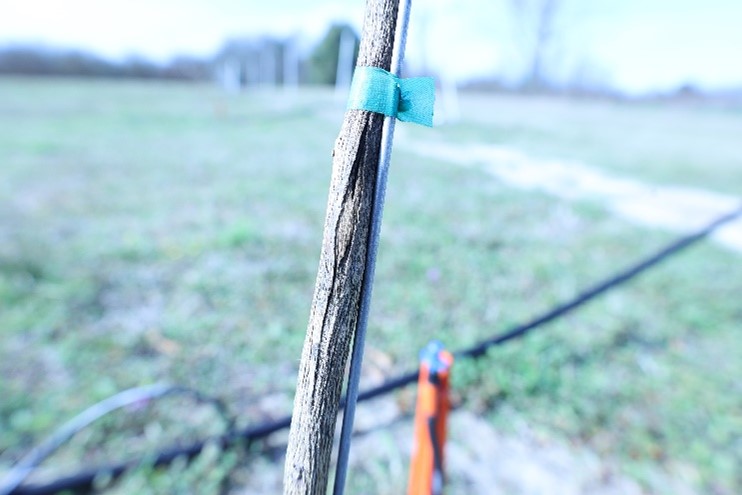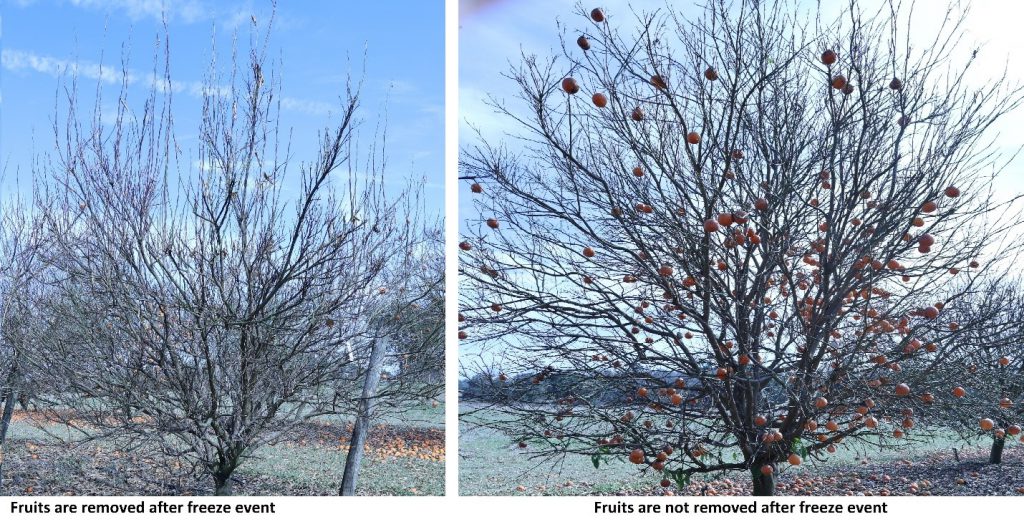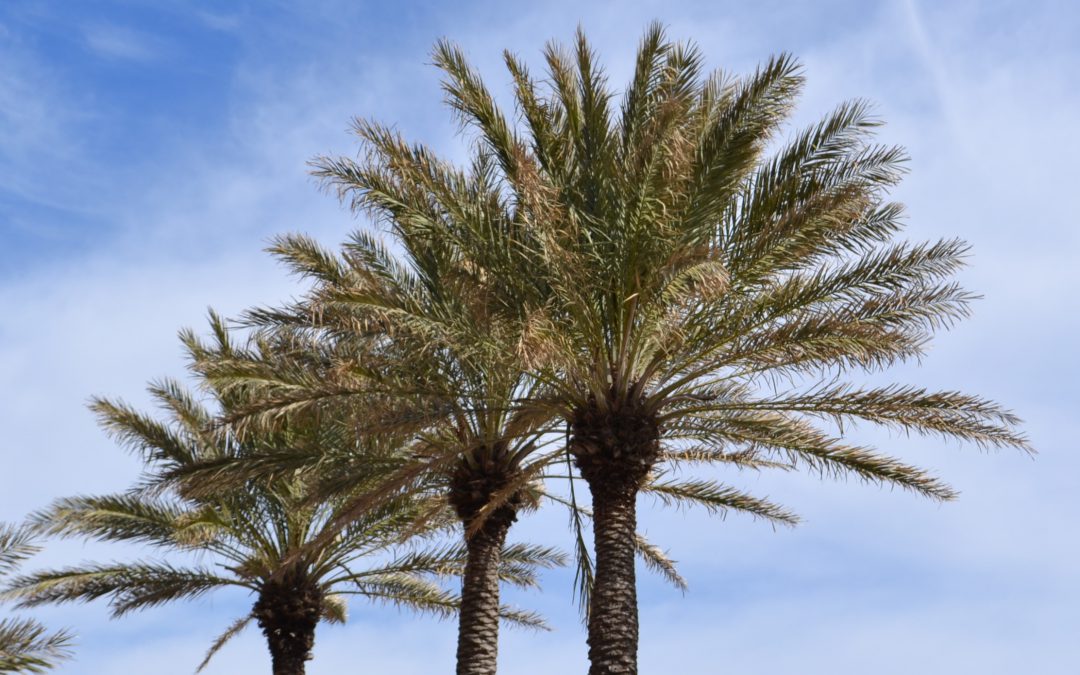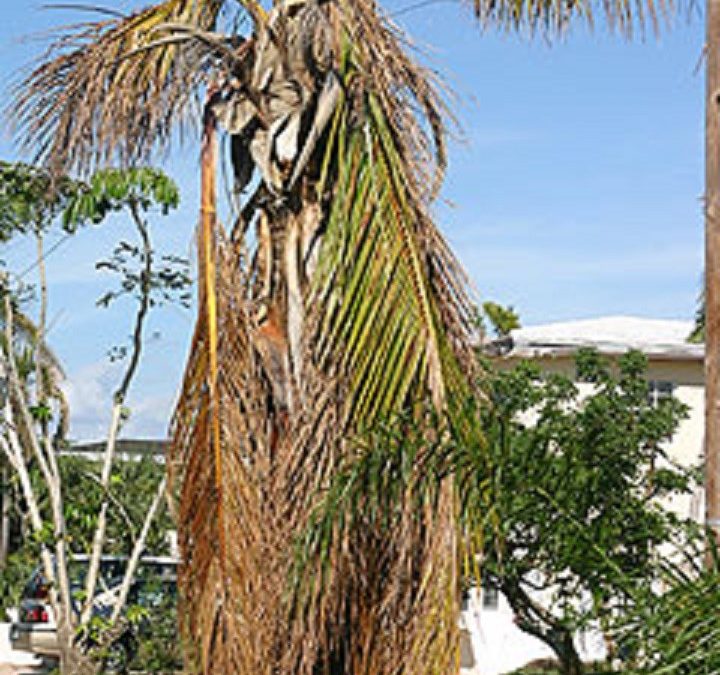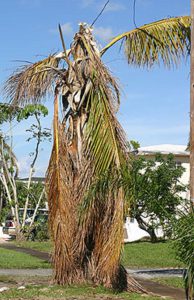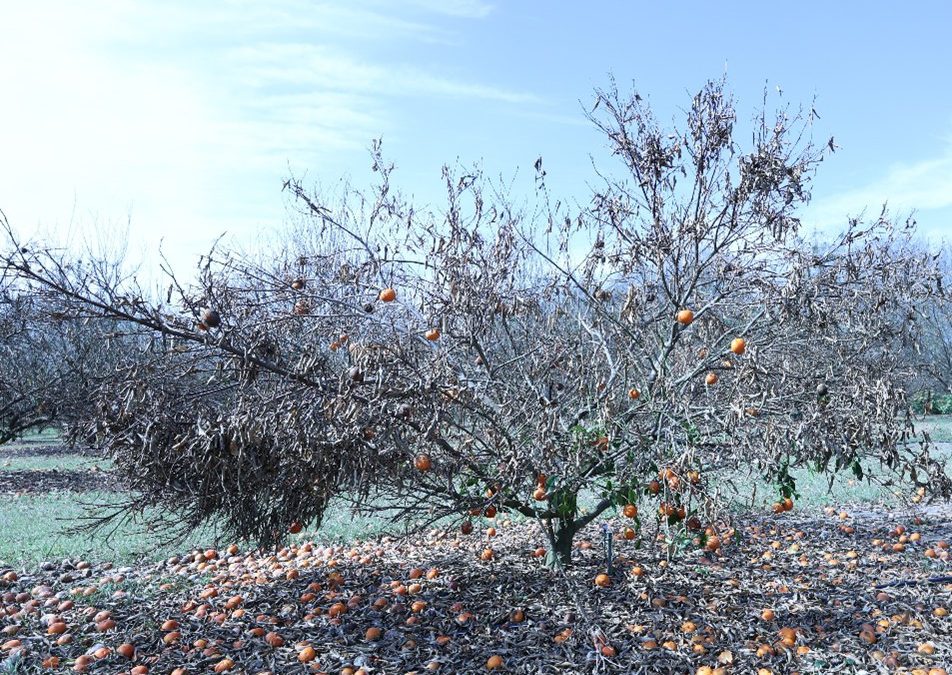
Post-Freeze Damage in Citrus: Symptoms and Recovery
Written by: Muhammad Adnan Shahid and Mujahid Hussain
What made this freeze event damaging?
The duration of temperatures below freezing determine the amount of damage to citrus plants. In January 2023 the temperature dropped down to 17 F and stayed at that temperature for a longer time than in recent years. Unlike 2022-23, during the winters of 2013-14, the recorded low temperature was 18 F for half an hour. Similarly, during 2014-15, the temperature touched 19 F and stayed only for 15 minutes. Except for these two winters, in the past 12 years, temperatures never dropped below 20 F. What made this freezing event of December 2022 devastating is the long freezing hours between 17-20 F for 11 hours and even more the temperature stayed for about an hour at 17 F (Fig. No.1).
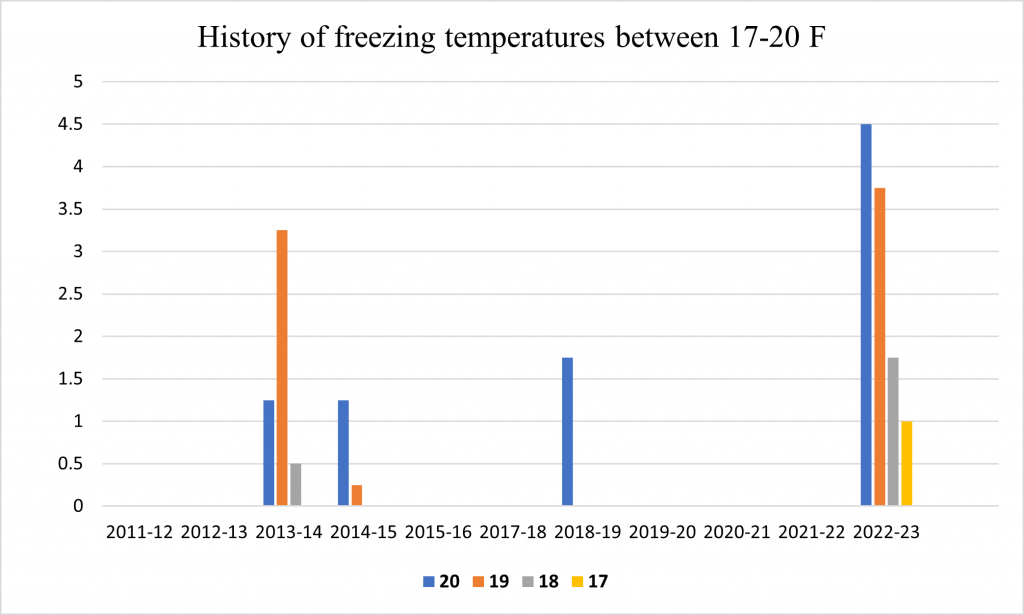
Symptoms After Freeze
Early Symptoms
The duration of appearance of symptoms after freezing was different for different citrus varieties. Even within the same varieties, the age of the plant and the rootstock are also factors that determined the duration of the appearance of symptoms. For example, in the UF 950 rootstock evaluation block at North Florida Research and Education Center in Quincy, the symptoms appeared on young UF 950 plants on Sour orange rootstock after 24 hours and after three days the plant completely turned brown.
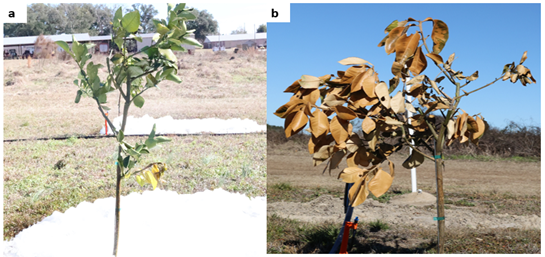
However, a few symptoms that appeared after about 24 hours of freezing were similar on all plants regardless of age, variety, and rootstock. These include the blackening of new leaves and branches, hardening and yellowing of leaves, and formation of greenish and brownish patches (Fig. No. 3). The leaves of old citrus trees also became curly, stunted, and yellow. During the freezing event, the fruits on the trees became hard due to the nucleation of water.
Low temperatures below freezing point cause the formation of ice crystals inside the plant, particularly in leaf tissue, causing a damaging effect of cell walls, and leaves appeared water-soaked upon thawing when temperature rose above the freezing point (Fig. 4).
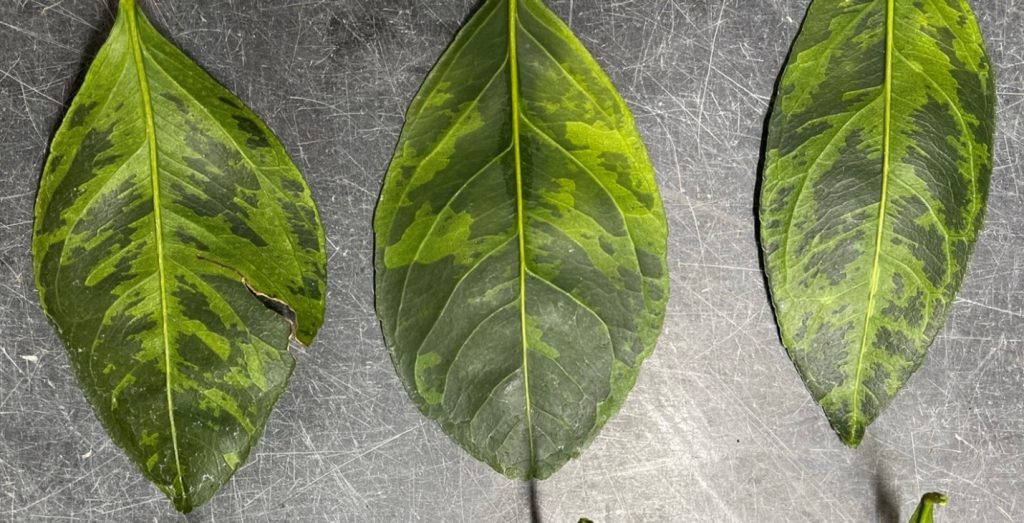
Late Symptoms
One week after freezing, leaves started curling – turning brown and dry. At this stage, both leaves and fruits dropped very quickly, within a week giving plants a bush like appearance (Fig. No. 5 and 6). The fruits that remained on the tree developed multiple symptoms depending on the varieties. Fruits of some varieties formed micro-pits on the peel, however, the fruits of other varieties showed patterns of bright orange and yellow colors (Fig. No. 6a). The rotting leaves and fruits also attracted ladybug beetles, consequently this increased populations of other insects in freeze damaged citrus groves. You should keep in mind that the fruits that have been harvested after freezing need extra care as these fruits are more prone attacked by rotting fungi.
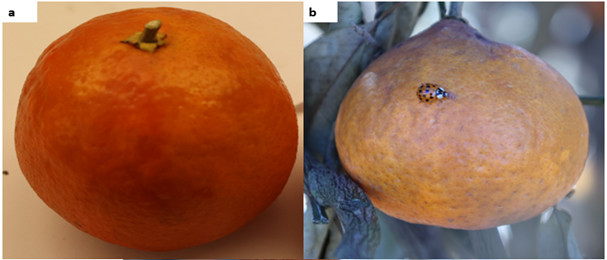
Bark splitting or cracking is a late symptom of freeze damage. Bark splitting or cracking will mostly be seen on stem and branches directly exposed to the sun. Bark splitting starts when sun light increases the temperature on the surface of the bark during daytime, but temperature drops after sun set resulting in unequal shrinkage and contraction of bark and inner plant tissues (Fig 8). Dropping of leaves and fruits is a good indication of plant survival, but if leaves dry while attached and don’t drop then it’s the sign of severe damage to internal tissue with a low chance of plant recovery (Fig 9)
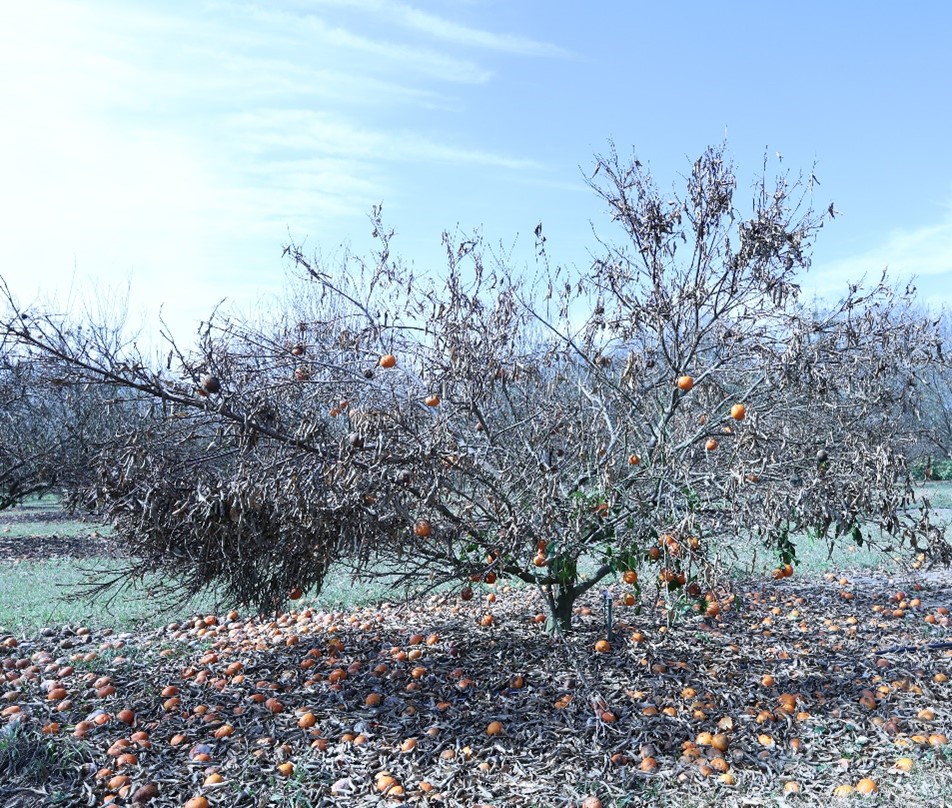
Recovering Plant After Freeze Damage
The recovery of plants is entirely linked to the level of damage to the plant internal tissues during the freeze event. Freezing damage can exacerbate the plant’s health, thereby minimizing the recovery of the plant. However, plants can recover if the internal cells (cambium and xylem and phloem) are alive enough to regenerate the branches. After an extreme freeze event, like what happened in December 2022, some citrus plants will recover in spring due to the presence of living cells in the branches and stems, but if the internal transportation system is damaged, the plant again starts to die back for the next several months. You should not apply any recovery techniques immediately after the freeze event. The best strategy is to wait for the spring to see if plants are giving any indication of recovery and observe their growth at least till May-June.
Fertilization
It is true that after damage, plants require nutrients to regenerate and grow but the application of nutrients is critical as excessive fertilization can also increase the risk of damage. Do not apply any fertilizer until new growth starts in spring. Fertilizers should be applied frequently, but rates should be decided depending on the degree of damage. The plants that are severely damaged will not be able to produce fruits in the next season therefore, the rate of fertilizer should be lowered to promote a slow recovery, as the damaged plants will not be able to uptake all applied nutrients due to slow water flow caused by minimum transpiration rate in the absence of leaves. In this case, any excessive application of fertilizer can cause toxic effects that can further halt the recovery of plants. The application of micronutrients is also important for the recovery of plants.
Plant Protection
Care should be taken to protect the plants from pathogens, insects, and weeds to enhance recovery. Citrus plants regenerate in the spring and aphids and whiteflies like to attack the young leaves, branches, and shoots. Therefore, an effective plant protection plan should be devised that includes the application of insecticides and fungicides. In general, one to two applications of fungicide should be planned along with nutritional spray to prevent infection on new growth. Removal of all fruit from freeze damaged trees is also important for quick recovery (Fig 10)
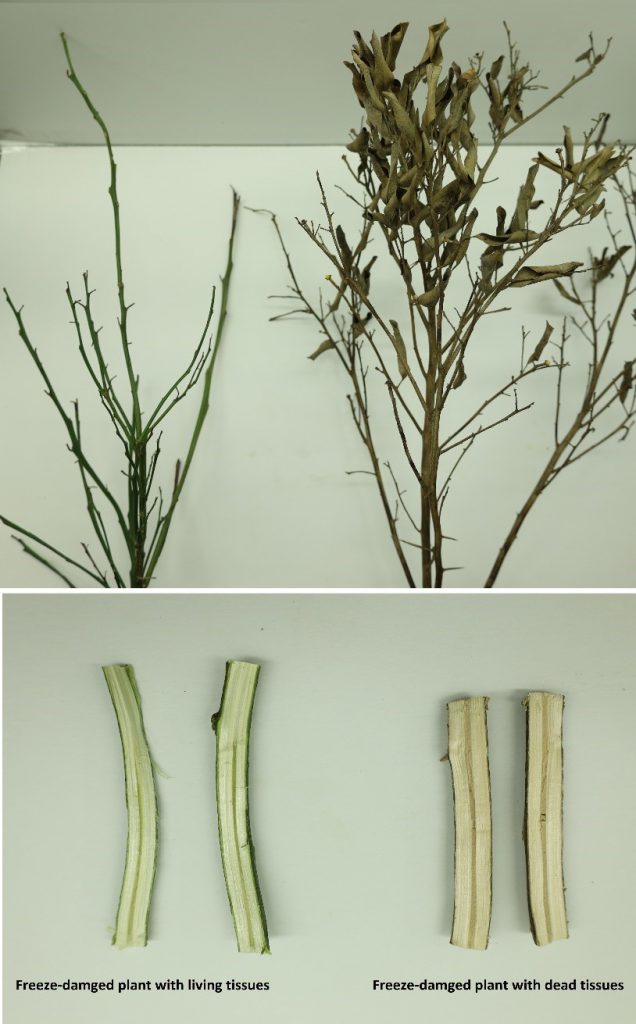
Pruning
Pruning should be avoided because it is not clear how much damage has been done to the plant. Pruning should be delayed until spring or summer. Ideally, pruning should be done on living wood to make sure that all the damaged parts have been removed. If the citrus tree has been damaged below the rootstock/scion union, it is better to re-graft the new scion on the rootstock instead of pruning. Pruning of trees that have been damaged below the scion union will result in the generation of rootstock. Therefore, re-grafting the plant or replanting is the best option. The Fruit Physiology Lab at NFREC-Quincy is developing tissue imaging techniques for quick estimation of percentage of tissue damage in freeze affected citrus tree shoots and roots.
Irrigation
Irrigation after freeze damage should be reduced. Damaged plants do not uptake as much water as healthy plants, therefore, excessive water in roots can cause the nutrients to move away from the plants and even can cause suffocation for young emerging roots. It is not recommended to completely cut off the water supply, because this can further damage the plants.
Research
The Fruit Physiology Lab at NFREC-Quincy is developing tissue imaging techniques for quick estimation of percentage of tissue damage in freeze affected citrus tree shoots and roots. A series of preliminary studies on the use of growth hormones (brassinosteriods, abscisic acid and jasmonic acid) and nutrients (silicon, K and Zn) to improve the cold hardiness is in progress. Preliminary data indicates that the use of growth hormones and plant beneficial nutrients has the potential to reduce freeze damage (Fig 12), but more detailed research and validation in large scale field trials is required. Postdocs and graduate students in The Fruit Physiology Lab at NFREC-Quincy are fully engaged with different research projects to improve the cold hardiness in citrus by hormonal and nutritional therapies. Recently, the lab got a funding to study new scion and rootstock combinations with high cold tolerance.
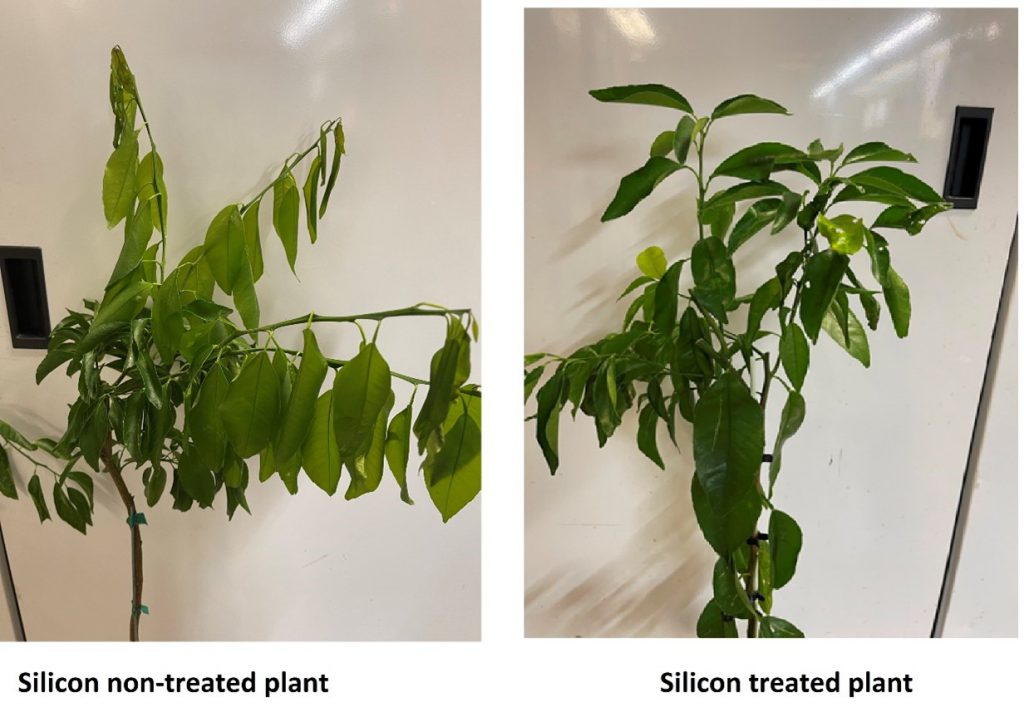
Conclusion
Florida has faced record freezing this winter season with recent events that occurred in the last week of December 2022 causing severe damage to citrus trees in North Florida. Citrus growers in South Florida are already fighting with the HLB disease and freeze damage in the North has added to the damage to the citrus industry in Florida. Careful planning and proper care can help damaged citrus trees to recover and start fruiting again. Trees with little damage to their woody parts will recover soon and start fruiting in the next season. However, the trees with more damage to their woody parts will take two or more years to recover enough to start fruiting. Therefore, proper assessment of the damage is important and recovery strategies should be devised according to the degree of damage. Recent freeze events gave us a big message that microsprinklers are not enough freeze protection for established trees. There is also a need to identify growth hormones, nutrients, or combinations of which can improve the cold hardiness of upper plant parts. In addition, exact estimation of recent freeze damage won’t be accurate until April-June.

